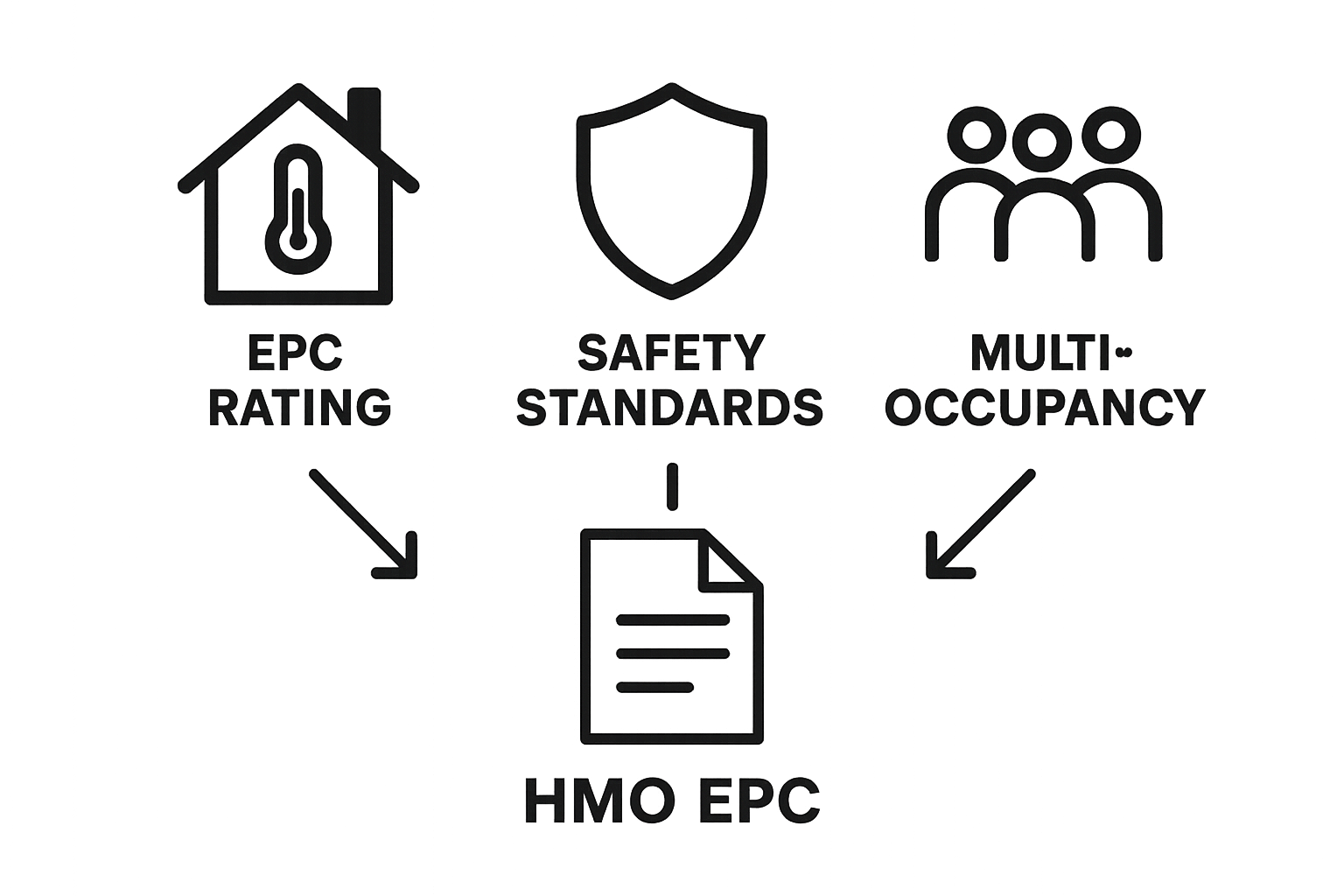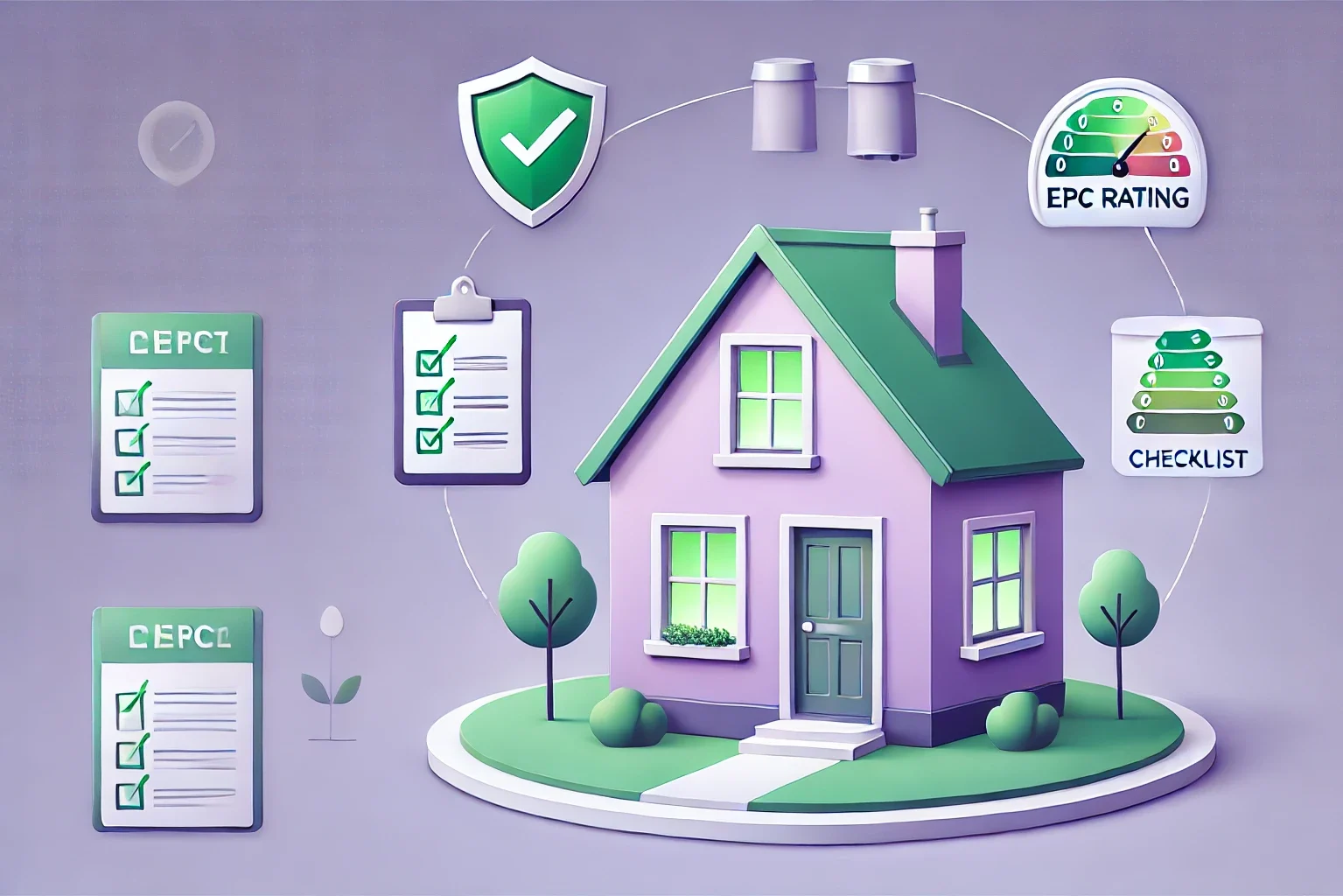Property investors and landlords face a mountain of paperwork when managing HMOs. Most see the Energy Performance Certificate as just another tick-box exercise or a way to keep regulators off their backs. But did you know that properties with better energy efficiency ratings can fetch noticeably higher rents and attract more reliable tenants? Suddenly that HMO EPC is not just a legal duty. It is becoming a powerful tool that can shape both your property’s value and your tenants’ quality of life.
Quick Summary
| Takeaway | Explanation |
|---|---|
| HMO EPC ensures energy efficiency compliance | The certification combines energy performance with safety standards, essential for regulatory compliance in multi-occupancy properties. |
| Higher efficiency ratings boost property value | Properties with better energy ratings attract premium prices and more tenants, positively impacting market attractiveness. |
| Tenants benefit from clear energy ratings | The HMO EPC provides tenants with transparency on utility costs and property comfort, guiding their housing decisions. |
| Landlords face increasing compliance responsibilities | Compliance with HMO EPC standards is crucial to avoid penalties and ensure properties meet safety requirements. |
| Proactive energy improvements enhance tenant satisfaction | Landlords can address energy efficiency recommendations to improve living conditions and potentially reduce long-term costs. |
Defining HMO EPC: What Does It Mean?
An HMO EPC represents a critical documentation requirement for Houses in Multiple Occupation (HMO), combining energy performance assessment with specific property management standards. Understanding this certification helps property investors, landlords, and tenants navigate regulatory compliance and property efficiency expectations.
The Core Components of HMO EPC
The HMO EPC consists of two primary elements that work together to provide comprehensive property information. First, the Energy Performance Certificate evaluates the property’s energy efficiency using a standardised grading system from A to G. This assessment examines critical aspects like insulation quality, heating systems, and overall building construction. Our detailed guide on HMO property assessments can provide further insights into these evaluations.
Second, the HMO certification ensures the property meets specific safety and habitation standards required for multi-occupancy residential spaces. These standards protect tenants by mandating minimum living conditions, proper facilities, and adherence to health and safety regulations.
Significance for Property Stakeholders
For landlords and property investors, obtaining a comprehensive HMO EPC is not just a legal requirement but a strategic asset. The certification offers several key advantages:
- Provides transparent energy efficiency ratings
- Highlights potential improvement areas for property value
- Demonstrates compliance with UK housing regulations
- Helps estimate potential utility cost savings
According to government guidelines on housing standards, properties must meet specific criteria to be classified and certified as suitable HMOs. The EPC serves as a crucial document in this verification process, offering an objective assessment of the property’s condition and potential.
Ultimately, the HMO EPC represents more than a bureaucratic requirement. It is a comprehensive tool that balances tenant protection, energy efficiency, and property management standards within the UK’s evolving housing landscape.
The Importance of HMO EPC in Property Investment
The HMO EPC plays a pivotal role in modern property investment strategies, serving as a comprehensive tool for evaluating property potential, financial viability, and long-term sustainability. For serious investors, understanding its significance goes far beyond mere regulatory compliance.
Financial Impact and Value Assessment
An HMO EPC provides critical insights that directly influence investment decisions and property valuation. Investors can leverage the energy efficiency ratings to estimate potential operational costs, predict maintenance requirements, and assess the property’s overall market attractiveness. Learn more about selling HMO properties with strategic efficiency considerations.
Properties with higher energy efficiency ratings typically command premium market prices and attract more discerning tenants. Investors who proactively address energy performance can potentially increase property value, reduce long-term maintenance expenses, and create more attractive rental propositions.
Regulatory Compliance and Risk Management
Navigating the complex landscape of property investment requires meticulous attention to regulatory standards. According to government guidelines on energy performance standards, upcoming legislative changes will mandate stricter energy efficiency requirements for rental properties.
Key considerations for investors include:
- Anticipating potential future regulatory modifications
- Understanding potential financial penalties for non-compliance
- Proactively planning energy efficiency upgrades
- Maintaining competitive market positioning
Strategic Investment Planning
Beyond immediate financial implications, the HMO EPC serves as a strategic planning instrument. Investors can use the detailed assessment to:
- Identify potential energy efficiency improvements
- Estimate future renovation costs
- Calculate potential return on investment for upgrades
- Develop long-term property enhancement strategies
By treating the HMO EPC as a comprehensive diagnostic tool rather than a mere bureaucratic requirement, property investors can transform regulatory compliance into a competitive advantage, ensuring their portfolios remain resilient and adaptable in an evolving real estate market.
How HMO EPC Impacts Tenants and Landlords
The HMO EPC is not just a technical document but a critical instrument that fundamentally reshapes the relationship between tenants and landlords, creating transparency, accountability, and mutual understanding about property performance and living standards.
The table below compares how the HMO EPC process and certification directly impact both landlords and tenants, outlining the respective benefits and responsibilities described in the article:
| Stakeholder | Key Benefits/Responsibilities |
|---|---|
| Landlord | Ensures regulatory compliance, improves property value, manages costs |
| Landlord | Proactively implements recommended improvements |
| Landlord | Maintains up-to-date certification and addresses compliance issues |
| Tenant | Gains transparency on property energy efficiency and utility costs |
| Tenant | Benefits from improved living comfort and safety standards |
| Tenant | Is protected by minimum habitability and health requirements |
Tenant Benefits and Protections
For tenants, the HMO EPC serves as a powerful tool for making informed housing decisions. By providing clear energy efficiency ratings, tenants can anticipate potential utility costs, understand the property’s environmental impact, and assess overall living comfort. Explore tenant rights with our comprehensive HMO guide to understand these nuanced protections.
Moreover, the certification process ensures that properties meet minimum safety and habitability standards, protecting tenants from substandard living conditions. The detailed assessment highlights potential health risks, insulation quality, and heating system effectiveness, giving tenants greater confidence in their rental choices.
Landlord Responsibilities and Opportunities
Landlords face increasingly stringent regulatory requirements surrounding property management. According to government guidelines on energy performance standards, upcoming legislative changes will mandate higher energy efficiency standards, potentially saving private renters significant amounts on energy bills.
Key responsibilities for landlords include:
- Maintaining up-to-date EPC documentation
- Implementing recommended energy efficiency improvements
- Ensuring properties meet minimum regulatory standards
- Proactively addressing potential compliance issues
Financial and Market Dynamics
The HMO EPC has transformed property valuation and rental market dynamics. Properties with higher energy efficiency ratings can command premium rental prices, attract more desirable tenants, and demonstrate a landlord’s commitment to quality and sustainability.
Financial implications extend beyond immediate rental income. Landlords who invest in energy-efficient upgrades can:
- Reduce long-term maintenance costs
- Increase property market value
- Attract environmentally conscious tenants
- Minimise potential future retrofit expenses
Ultimately, the HMO EPC represents a collaborative framework that aligns tenant welfare with landlord interests, driving continuous improvement in housing standards and energy performance across the private rental sector.
Key Components of HMO EPC Explained
The HMO EPC is a multifaceted document that encompasses several critical elements, providing a comprehensive assessment of a property’s energy performance, safety standards, and overall habitability. Understanding these components is essential for both landlords and tenants navigating the complex landscape of property management.

Energy Efficiency Rating System
At the core of the HMO EPC is the Energy Efficiency Rating, a standardised grading system ranging from A to G, with A representing the most energy-efficient properties. This rating is calculated through a detailed analysis of multiple property characteristics, including insulation quality, heating systems, and overall building construction. Learn more about property assessment strategies to understand how these ratings are determined.
According to government guidelines on energy performance standards, the rating provides a clear, comparable metric that helps stakeholders understand a property’s energy consumption potential and environmental impact.
Detailed Property Assessment Components
The HMO EPC encompasses a comprehensive evaluation of property features, including:
- Thermal insulation quality
- Heating system efficiency
- Windows and door thermal performance
- Hot water system effectiveness
- Lighting energy consumption
- Potential carbon dioxide emissions
Each component is meticulously assessed to provide a holistic view of the property’s energy performance.
To help clarify what is evaluated during an HMO EPC assessment, the following table summarises the key components assessed and their specific focus within the property:
| Component | Focus of Assessment |
|---|---|
| Thermal insulation quality | Quality and effectiveness of insulation materials |
| Heating system efficiency | Type, age, and performance of heating installations |
| Window and door performance | Insulation properties and draught prevention |
| Hot water system effectiveness | Energy use and output efficiency |
| Lighting energy consumption | Type and efficiency of lighting fixtures |
| Carbon dioxide emissions | Estimated output based on energy use |
The assessment goes beyond mere numbers, offering actionable recommendations for potential improvements that can enhance energy efficiency and reduce operational costs.
Recommendations and Future Improvements
A crucial aspect of the HMO EPC is its forward-looking recommendations section. This component provides specific, tailored suggestions for property owners to:
- Reduce energy consumption
- Lower utility costs
- Improve overall property performance
- Enhance tenant comfort and satisfaction
- Increase property market value
These recommendations are not just theoretical but offer practical, cost-effective strategies for incremental property improvements. By following these guidelines, landlords can progressively enhance their property’s energy efficiency, ultimately creating more sustainable and attractive rental spaces.
The HMO EPC thus represents more than a regulatory requirement. It is a dynamic tool for continuous property improvement, balancing environmental responsibility with economic pragmatism.

Real-World Implications of HMO EPC in Practice
The HMO EPC transcends theoretical documentation, representing a profound mechanism for transforming property management, tenant experiences, and broader environmental sustainability strategies. Its practical applications reveal complex interconnections between regulatory compliance, economic incentives, and social responsibility.
Investment and Property Valuation Dynamics
In the contemporary property market, the HMO EPC serves as a critical determinant of investment attractiveness. Properties with superior energy efficiency ratings not only command premium prices but also demonstrate long-term value potential. Explore strategic property investment approaches to understand how energy performance impacts market positioning.
According to government guidelines on energy performance standards, upcoming legislative changes will fundamentally reshape property investment strategies, compelling landlords to prioritise energy efficiency as a core valuation metric.
Compliance and Financial Implications
The real-world impact of HMO EPC extends far beyond aesthetic ratings. Non-compliance can result in significant financial penalties and market restrictions. Landlords must navigate a complex regulatory landscape that increasingly emphasises energy performance as a fundamental requirement.
Key practical considerations include:
- Potential fines for inadequate energy performance
- Restrictions on property rental and sales
- Mandatory upgrade requirements
- Increased maintenance and retrofit costs
- Potential reduction in property marketability
Environmental and Social Responsibility
Beyond immediate financial considerations, the HMO EPC represents a critical instrument for addressing broader environmental challenges. By mandating energy efficiency standards, these certifications contribute to national carbon reduction strategies and support sustainable urban development.
Practical environmental benefits encompass:
- Reduced carbon emissions
- Lower energy consumption
- Decreased household energy costs
- Improved living standards
- Enhanced property resilience
The HMO EPC thus emerges as more than a bureaucratic requirement. It is a sophisticated tool for driving systemic change, aligning individual property management with wider societal goals of sustainability, efficiency, and responsible resource utilisation.
Take Control of Your HMO Compliance and Boost Your Investment Value
Struggling with the complexities of HMO EPC requirements? As highlighted in our guide, staying compliant and improving your property’s energy efficiency can feel overwhelming, but these steps are essential for protecting your investment, attracting quality tenants, and avoiding costly penalties. Landlords and investors face real pressure to meet ever-tightening regulations, and a missed detail could put your income or reputation at risk. Now is the time to act on the insights you’ve gained and ensure your property stands out in the market.

Start by exploring the complete range of solutions and expert guidance on agenthmo.co.uk. Here you can connect with trusted HMO professionals, discover tips for EPC improvements, and access our property valuation tools to see how compliance could affect your returns. Take action now, secure your property’s future and turn regulatory hurdles into growth opportunities. Visit agenthmo.co.uk for step-by-step support and transform your compliance into real value today.
Frequently Asked Questions
What is an HMO EPC?
An HMO EPC, or Houses in Multiple Occupation Energy Performance Certificate, is a document that combines energy performance assessment with safety standards aimed at properties occupied by multiple tenants.
Why is an HMO EPC important for landlords?
Obtaining an HMO EPC is essential for landlords as it not only meets legal requirements but also enhances property value, demonstrates compliance with regulations, and helps in managing operational costs effectively.
How does the HMO EPC affect tenants?
The HMO EPC provides tenants with clarity about a property’s energy efficiency, enabling informed decisions regarding utility costs and overall living quality, while also ensuring safety and habitability standards are met.
What are the key components assessed in an HMO EPC?
An HMO EPC evaluates the energy efficiency rating, insulation quality, heating systems, and other crucial aspects of the property to ensure it meets regulatory standards and provides recommendations for potential improvements.


